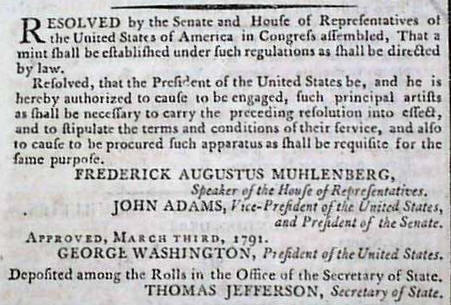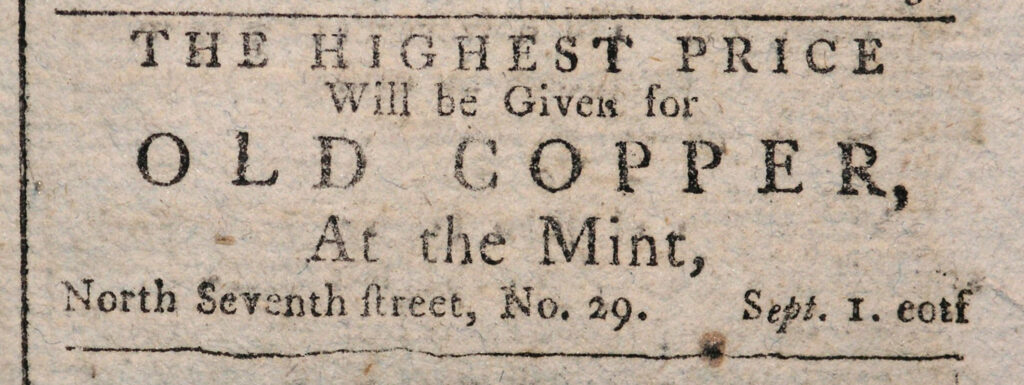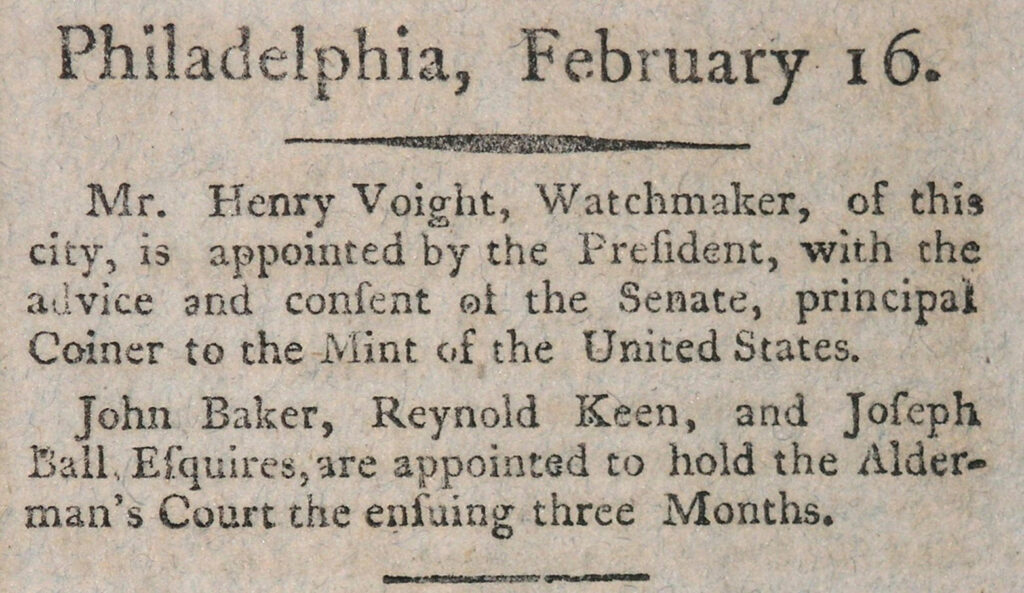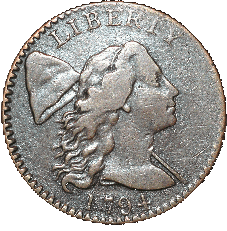Arguably the most studied, written about and interesting of all US coins are the copper Large Cents produced between 1793 and 1857. Of these those of 1794 have motivated the most passionate of collectors. The 1794 large cents have the most traceable of pedigree chains; many of their images can be found in sales catalogs back to the 19th century. This web site evolved as an offshoot of an exhibit at the 2004 Early American Coppers Club convention in San Diego which featured all 58 collectible varieties of 1794 Large Cents. The exhibit coins were chosen based on their interesting pedigrees rather than their grade condition - lineages extending to Mickley, Maris, Frossard, Hays, Zug, Prosky, Hines, Gilbert, Steigerwalt, Clapp, and many other noted collectors of the distant, and not-so-distant, past.
In the early years following the American Revolution the various mediums for commercial dealings consisted of world and colonial currencies, produce, fowl, livestock, alcohol, wampum plus assorted coins of Spanish, English, French, German, Dutch and Portuguese origins as well as various other issues. Along the Atlantic seaboard, bills of exchange, commercial transactions, and other obligations were usually expressed in Spanish milled dollars or British pounds sterling, both of which were composed of fractional components.
Matters of finance and monetary policy had always been central to the Continental Congress. A committee on monetary policy was formed as early as April 19, 1776, and charged with examining and verifying the value of silver and gold coins then circulating in the colonies. The first effort of the committee was submitted on May 22 but was put aside. On July 24, just two weeks after composing the Declaration of Independence, Thomas Jefferson was appointed to the committee. On September 2, 1776, Jefferson submitted the committee's final report which included a chart listing the primary silver and gold coins in circulation with their equivalent values in relation to the Spanish American silver dollar. Interestingly, rather than use fractions, Jefferson was the first to use decimal notation to express these equivalent monetary values. About six months later, on February 20, 1777, another congressional committee concerned with matters pertaining to the treasury recommended a mint be established for the coining of money, but no further steps were taken on their recommendation. As the war continued, metal was recycled to produce canon, rifles, bullets as well as other equipment needed for military operations. Small denomination paper currency replaced much of the coinage.
The Bank of North America was chartered by the Congress in 1781. This first commercial bank opened for business on January 7, 1782, in Philadelphia. Organized under a plan developed by Superintendent of Finance Robert Morris, the bank was established primarily to provide financing for the expenses of the American War of Independence.
On January 15, 1782, Morris recommended establishment of a national mint and the adoption of a decimal coinage system. The following year Morris commissioned Benjamin Dudley, a British die engraver living in Boston, to prepare dies. Dudley was paid $72 on May 5, 1783 for “sinking, case hardening, &c. four Pair of Dies for Public Mint.” On April 2, 1783 Dudley presented the first sample Nova Constellatio silver pattern bearing a denomination of 1,000 units (mark.) Other denominations of 500 units (quint), 100 units (bit) and 5 units were later designed and struck. Despite intense efforts an actual mint failed to materialize, and the pieces produced remained as patterns with no regular-issue counterparts being produced.
On July 6, 1785, Congress approved the dollar as the basic Currency unit with decimal subdivisions. However, no action was taken to establish a mint.
On April 15, 1790, Congress instructed Secretary of the Treasury Alexander Hamilton to draft plans for the establishment of a national mint. On January 28, 1791, Hamilton submitted his Report on the Mint for consideration by Congress. In it he encouraged the use of coinage as part of his vision of developing a market economy. Contemporary commercial exchange, among commoners, still relied in large degree upon bartering. Copper cents and half cents were intended to benefit those of lesser means by enabling them to purchase goods in smaller quantities.
On March 3, 1791, President George Washington approved the joint resolution of Congress which established the Mint. However, Hamilton regretted that the Mint was lodged under the jurisdiction of the Department of State; apparently as a concession to Secretary Jefferson’s interest in coinage. While serving as the United States minister in Paris, Jefferson had visited the royal mint and was intrigued by a coinage press, developed by Jean Pierre Droz, which impressed both obverse and reverse designs simultaneously.
Large Cents are divided into three general types: Early Dates [1793-1814], Middle Dates [1816-1840] and Late Dates [1840-1857]. While there are many aficionados of each of these groupings it is considered that the most challenging are also the most ancient and those produced under the most primitive conditions; the Early Dates.
The Early Dates are further divided into five sub-groupings: Flowing Hair (Chain), Flowing Hair (Wreath), Liberty Cap, Draped Bust and Classic (Turban Head). Of these sub-groups the Liberty Cap (1793-1796) cents are generally regarded as the most beautiful design and are often reverently collected and cherished. Of the Liberty Cap design; the 58 collectible varieties of the year 1794 may provide the foundation for a lifetime of study.
The Liberty Cap large cents of 1793-1796 are surely the "classics" of early American copper coinage. They represent the third attempt of the infant Philadelphia Mint's quest for an acceptable cent design; succeeding those of the earlier Chain and Wreath designs which inaugurated this United States series in 1793. The Liberty Cap design was created by Joseph Wright, a Bordentown, New Jersey native and portraitist whose most famous works were his 1783 paintings of George and Martha Washington. Wright began work at the Mint, in August 1793, as an engraver and die-sinker under the renowned scientist and Mint Director David Rittenhouse. A catastrophic yellow fever epidemic broke out in Philadelphia shortly after Wright began work. No one knew the cause of this "mysterious" malady which was to claim more than 4,000 lives that summer. [It wasn't until 1900 that Maj. Walter Reed determined that yellow fever was spread by mosquitoes] Joseph Wright contracted the fever and died on September 13, after creating a legacy in what many consider to be the most beautiful US coin design; the Liberty Cap cents S-12 through S-20. Wright most likely died without having seen any of his coins struck.
For his Liberty Cap cent Wright drew inspiration from a popular theme dating back to Roman times; that of the Liberty or Phrygian (pileus in Latin) cap. Wright is believed to have designed the obverse of the 1783 Libertas Americana medal {see the images section of this web site] which was minted in Paris. This famous medal depicted a lovely Lady Liberty facing left, her hair unbound and flowing in the wind. She carried a pole, topped by a pileus, over her shoulder. The Libertas Americana medal commemorated the American victories at Saratoga and Yorktown and was a private project of Benjamin Franklin. The medal was distributed to many VIPs on both continents. It served its purpose well as a symbol of French support for the American revolutionary cause.
No other U.S. coins have attracted such intense study as the Liberty Cap cents. The evolution of large cent research appears to have began with Sylvester S. Crosby and J.N.T. Levick who, in April 1869, published the first treatise on the cents of 1793 which appeared in The American Journal of Numismatics . Also in 1869 Dr. Edward Maris, a Quaker doctor from Philadelphia, published a pamphlet identifying and naming 39 varieties of 1794 cents. Both 19th century dealer Samuel Hudson Chapman and 20th century cataloguer Dr. William H. Sheldon agreed that serious collectors would eventually "gravitate to early copper" and that, once there, many would end up "specializing in the date 1794,"
Copper cents were still a novelty when Wright created his dies. Most Americans had not yet seen any of the new Federal coinage, still limited to cents and half cents. The citizens of the growing nation, only in its sixth year under the Constitution, thought in terms of Spanish milled dollars, state copper coins and private tokens (when they thought of coins at all). So it was most important that the public accept the new cent, particularly considering the harsh reviews given Chain cent design when it was first released. This criticism may have been on Wright's mind as he began his work.
Wright turned Liberty to the right and replaced the beehive-like pileus with a soft Phrygian cap worn in ancient times by newly freed slaves to signify their liberation. The reverse presented a sparser laurel wreath than the preceding coinage, bearing single berries on individual stems. The first Wright coins were in higher relief than later designs, their obverses shifting from beaded to denticled borders. Their edges bore the incuse inscription ONE HUNDRED FOR A DOLLAR, ending in a leaf.
After Wright's death the Liberty Cap design was modified by engraver Robert Scot who was engaged for the Mint by Director Rittenhouse. The Scot varieties of S-21 through S-66 display a much lower relief. Later, Scot's design was replaced by that of another yet engraver, John Smith Gardner, hired in November of 1794 and responsible for varieties S-67 through S-72.
Ongoing studies were made by such numismatists as Ed. Frossard, Thomas L. Elder, David Proskey and Howard R. Newcomb. The greatest modern large cent researcher was Dr. William H. Sheldon, whose definitive Early American Cents was published in 1949 and revised in 1958 as Penny Whimsy with the aid of Dorothy Paschal and Walter Breen. "Sheldon numbers" have become the standard for designating the varieties of 1793 - 1814 cents; the variety number being preceded by his initial "S".
Sheldon lists five "Collectible" Liberty Cap varieties for 1793 and fifty-eight for 1794 plus several extremely rare "Non-Collectibles." The 1795 cent varieties number only eight, including four lettered edge, three plain edge and one ultra-rare reeded edge coin. Plain edges were made necessary by reduction of planchet weight from 208 grains to 168 grains near the end of the year. This weight change was necessitated by an increase in the price of copper, which had reached a point where it cost the Mint $1.22 to produce one hundred cents. There are also eleven "Collectible" Liberty Caps for 1796.
Sheldon's 1795 listing includes the controversial "Jefferson Head" cent with an unusual square-browed Liberty and pincer-like "crab claw" leaves in the wreath. Considering the ongoing efforts of some in Congress to replace the Mint with private contractors, many numismatists believe that these rare coins were privately struck as patterns for a coinage contract sought by Philadelphia saw-maker John Harper.
One unusual variety is the Starred Reverse (S-48), bearing 94 tiny 5-pointed stars circling the reverse rim. This die was "discovered" by Henry Chapman on June 1, 1876. Brothers Samuel and Henry Chapman, along with Dr. Edward Maris [the first man to make a study of the 1794 series]. The three were examining a lot of 1794 cents when H. C., examining a coin, exclaimed “Here is a die with minute stars around the reverse.” Dr. Maris confirmed the "discovery" and said that “it was previously unknown.” This "discovery" coin subsequently became a part of the Samuel Bispham Collection which was auctioned by S. H. Chapman in February of 1880. This coin, and its subsequent pedigree, is traceable to this day.
Another unusual variety is the Missing Fraction Bar (S-64), which omits the line between 1 and 100 in the fraction. Most researchers attribute the dies used between December 1794 and April 1796 to Gardner, a general technician pressed into service to help meet demand for cents of the new thin-planchet type. Coins of May to June 1796 were struck from dies once again cut by Scot. In mid-1796, the Liberty Cap design was replaced by Scot's interpretation of Gilbert Stuart's Draped Bust motif.
The Philadelphia Mint produced over 1.5 million Liberty Cap cents between 1793 and 1796. Most coins of this design encountered today range from Good to Very Fine. Coins from 1793 are the rarest, while coins dated 1795 and 1796 are the most readily available in high grade and are often sought by type collectors. Original red, mint luster is seldom seen, but natural patinas are very important in determining the coins' value, since copper can take on beautiful and stable surface colorations over the years. Variations in planchet quality, die preparation and striking patterns make these early cents challenging to grade. Generally the points of the design to first show wear are Liberty's hair at the forehead and above the ear. On the reverse, check the leaves next to the O and C in ONE.
Higher grade coins are eagerly sought but often very difficult to find. Keep in mind that these coins circulated many years before Philadelphian Joseph J. Mickley began his hunt for a cent of 1799; his birth year. Mickley was among the first to popularize coin collecting in this country. He was followed by many others, including America's first coin dealer, English-born Edward Cogan. Many of our Large Cent pedigrees may be traced to his era.



